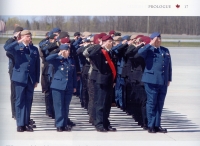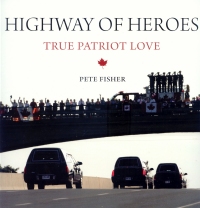| ________________
CM . . . . Volume XVIII Number 16 . . . . December 16, 2011
excerpt:
Since the remains of the first four Canadian fatalities of the war in Afghanistan were returned to Canadian soil in April 2002, all of the hearses have traveled a 172-kilometre route from CFB Trenton where repatriation to Canada begins, along the King’s Highway 401 (officially the Macdonald-Cartier Freeway) to the Don Valley Parkway in Toronto and eventually to the coroner’s office in downtown Toronto where autopsies are performed and from whence the soldiers’ remains are turned over to the families. Pete Fisher, a photojournalist based in Cobourg, ON, along the route, has been at the forefront of efforts to both document the repatriation of Canadian soldiers and to achieve official recognition of their ultimate sacrifice in service to the country. 
From the beginning, “the brotherhood behind the uniforms of military and emergency services” has been an important and prominently visible part of a movement to acknowledge the soldiers and their bereaved family members traveling in the procession by lining the bridges over the highway, or standing along the route out of respect and patriotism. As more soldiers were killed, the number of civilians paying their respects continued to grow. Standardization of the time of repatriation services helped to encourage participation of average people (the grassroots), not just the military, police and firefighters in acts of remembrance. Fisher documents the lobbying that took place to have the section of the highway officially named the Highway of Heroes by the provincial government in August 2007 and the naming of the Toronto segment starting at the Don Valley Parkway designated the Route of Heroes by the City of Toronto. Some of the best writing in the volume focuses on the stories of family members, like Wendy and Ray, the mother and stepfather of Private Andrew Miller who was one of two medics killed in June of 2010. They tell of how comforted they felt seeing strangers waving flags, waving hands, or standing in silence along the route. Wendy and Ray’s responses are reinforced by two retired Ontario Provincial Police officers who were integral parts as drivers of the lead cars in most of the processions between 2002 and 2010 and who note that grieving families said that the public gesture of support helped them with their loss. This is reiterated in several personal essays by family members included in the volume. Fisher includes related stories of Canadians who have tried to reach out to soldiers and their families. Captain Wayne Johnston started a charity to support wounded soldiers. Arnie Williamson strives to obtain municipal or provincial flags from the homes of the deceased soldiers that he flies at the last overpass that the procession travels under before turning onto the Don Valley Parkway. These flags are later shipped with an explanatory letter to the families. Obtaining flags and their delivery often involves willing helpers in diverse parts of the country. Lobbying of businesses with flag poles situated along the highway has also resulted in flags flying at half mast when processions drive past. Perhaps the greatest failing of the book is the raw patriotic fervor that riddles the work. This is perhaps most obvious in the chapter “The Quest for a Coin” that records the intense lobbying that Fisher initiated to have the Royal Canadian Mint issue a commemorative collector coin depicting the Highway of Heroes. He makes no pretense at journalistic balance in his tenacious refusal to accept the Mint’s decision to not proceed with a coin, dismissing its defense that it had already issued 30 coins honouring veterans and Remembrance Day. Fisher’s oft repeated argument is that commemoration, whether in issuing a coin or flying a flag at half mast in contrast to official government of Canada protocol, is “the right thing to do.” Other points of view are not considered. He never considers the possibility that political correctness and a desire to be seen as “supporting the troops” may be as powerful a motivator as any intrinsic rightness of an action. (The Mint announced on Monday Oct. 31, 2011, that it will issue a collector silver coin with a face value of $10 to pay tribute to the war dead and the people who line the route of the Highway of Heroes to honour them.) The volume includes a complete list of fallen soldiers (and one journalist) up to July 8, 2011. Each is identified by her/his military title, age, home town, unit name, and date of death. The volume, with its copious colour photographs and frequent name dropping of soldiers in the text, makes for a touching tribute to the fallen soldiers and their families. I hope that Fisher will turn his tenacity to advocating on behalf of the hundreds of soldiers who have suffered physical and/or mental injuries in the course of military service for Canada. Recommended with reservations. Val Ken Lem is a librarian at Ryerson University in Toronto, ON.
To comment
on this title or this review, send mail to cm@umanitoba.ca.
Copyright © the Manitoba Library Association. Reproduction for personal
use is permitted only if this copyright notice is maintained. Any
other reproduction is prohibited without permission.
NEXT REVIEW |
TABLE OF CONTENTS FOR THIS ISSUE
- December 16, 2011.
AUTHORS |
TITLES |
MEDIA REVIEWS |
PROFILES |
BACK ISSUES |
SEARCH |
CMARCHIVE |
HOME |
